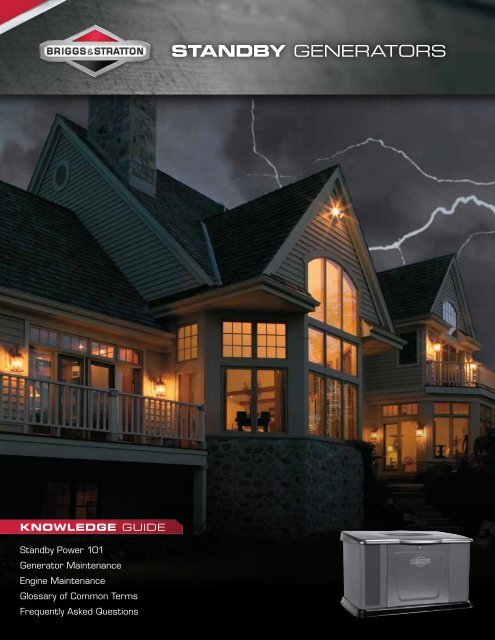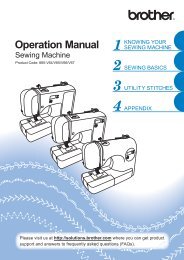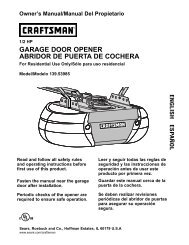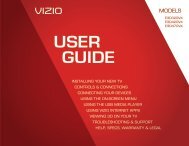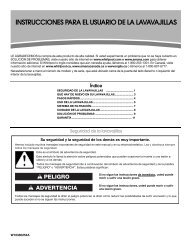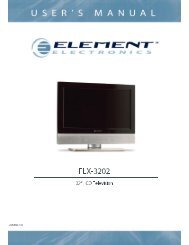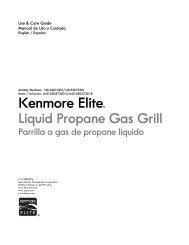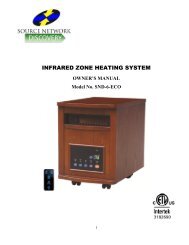STANDBY Generators
STANDBY Generators
STANDBY Generators
You also want an ePaper? Increase the reach of your titles
YUMPU automatically turns print PDFs into web optimized ePapers that Google loves.
KNOWLEDGE GUIDe<br />
Standby Power 101<br />
Generator Maintenance<br />
Engine Maintenance<br />
Glossary of Common Terms<br />
Frequently Asked Questions<br />
<strong>STANDBY</strong> <strong>Generators</strong>
<strong>STANDBY</strong> POWEr 101<br />
Understanding Your Power Needs<br />
The size of your generator isn’t determined solely on the square footage of your home. What’s most important is determining what<br />
you want powered to keep your family comfortable in the event of a power outage.<br />
Essential Power<br />
Interested in powering only a few essential times, such as your refrigerator, some lights, television, and perhaps a microwave?<br />
The Briggs & Stratton 8kW1 with a 50 Amp Automatic Transfer Switch provides power to 10 electrical circuits. Perfect for small<br />
homes.<br />
Essential Power – Plus!<br />
Essential Power- Plus! provides power for a select number of circuits as well as powering up to two air conditioners.<br />
Managed Whole House Power<br />
Do you want to power your essential items, but also have access to some additional high wattage appliances? The newly-designed<br />
Briggs & Stratton 10kW1 and 12kW 1 units, as well as the 16kW1 and 20kW1 can be paired with Automatic Transfer Switches that<br />
can power all of your essentials and up to two 5-ton air conditioners, while also providing access to additional high wattage items.<br />
Whole House Power<br />
If you are looking for true whole house comfort, the Briggs& Stratton 35kW1 and 45kW1 supply enough quiet,<br />
automatic backup power to manage the demands of most larger homes. The best backup power solution for extra-large or luxury<br />
homes.<br />
An authorized Briggs & Stratton dealer or your certified electrician can work with you to determine your exact power news prior to<br />
purchase.<br />
Keep Your System Running at Top Performance<br />
Complement your standby generator system with service-friendly accessories that help ensure reliable operation, powerful<br />
performance and extend the life of your generator. Ask an Authorized Briggs & Stratton Standby Generator Dealer for more<br />
information.<br />
• Maintenance Kits<br />
• Cold Weather Kits<br />
o Battery Warmer<br />
o Oil Heater<br />
1 This generator is rated in accordance with UL (Underwriters Laboratories) 2200 (stationary engine generator assemblies) and CSA<br />
(Canadian Standards Association) standard C22.2 No. 100-04 (motors and generators).<br />
Know Your Power Options - Portable versus Standby <strong>Generators</strong><br />
Portable <strong>Generators</strong> Standby <strong>Generators</strong><br />
Immediate solution during a power outage<br />
Can power a wide range of essential items such as interior lighting, refrigerators,<br />
freezers, sump pumps, garage door openers, computers and TVs<br />
Used in multiple applications, like camping, tailgating or construction sites<br />
Automatic solution, usually starts less than a minute after a power outage<br />
occurs<br />
Can power your whole house<br />
Stationary generator that’s installed to a home’s existing propane or natural<br />
gas line<br />
Quieter making them well-suited for both urban and suburban<br />
neighborhoods
Setting up Installation<br />
After you purchase a new Standby Generator system, it will need to be professionally installed. Your local Briggs & Stratton<br />
Authorized Standby Generator Dealer can handle the complete installation OR you can choose your own qualified electrician.<br />
1. Coordinate with a qualified electrician for installation of the Standby Generator and Automatic Transfer Switch.<br />
2. If the Standby Generator will be connected to a natural gas line, coordinate with a qualified gas installation company or<br />
plumber for proper gas line installation. Keep in mind that for optimal generator performance, your gas meter and pipe<br />
needs to be properly sized to supply the required gas pressure. If the Standby Generator will be connected to a propane fuel<br />
source, contact your propane gas company.<br />
3. Standby <strong>Generators</strong> must be installed to local code requirements. An Authorized Briggs & Stratton Standby Generator<br />
Dealer, or your local electrician, can coordinate with authorities for any inspections or permits that may be required.<br />
4. After installation, we encourage you to test the installed generator based on start-up instructions provided with the unit.<br />
5. Finally, register your new product.<br />
For additional information on Briggs & Stratton Standby <strong>Generators</strong>, visit www.powernow.com<br />
GENErATOr MAINTENANCE<br />
The generator warranty does not cover items that have been subjected to operator abuse or neglect. To receive full value from the<br />
warranty, the operator must maintain the system as instructed in the Operator’s Manual.<br />
All adjustments should be made at least once each season. Follow the requirements in the Operator’s Manual.<br />
Generator maintenance consists of keeping the unit clean. Operate the unit in an environment where it will not be exposed to<br />
excessive dust, dirt, moisture or any corrosive vapors. Cooling air louvers on the enclosure must not become clogged with snow,<br />
leaves, or any other foreign material. To prevent generator damage caused by overheating, keep the enclosure cooling inlets and<br />
outlets clean and unobstructed at all times.<br />
Check the cleanliness of the unit frequently and clean when dust, dirt, oil, moisture or other foreign substances are visible on its<br />
exterior/interior surface. Inspect the air inlet and outlet openings inside and outside the enclosure to ensure air flow is not blocked.<br />
DO NOT use direct spray from a garden hose to clean generator. Water can enter the engine and generator and cause problems.<br />
ENGINE MAINTENANCE<br />
An engine manual was packaged with this system. Refer to that manual for all engine-related maintenance topics, such as oil,<br />
oil filter, coolant, spark plugs and so forth. Proper engine cooling and lubrication are very important, so pay particular attention<br />
to these matters. Service part numbers for common maintenance parts are available through our Briggs & Stratton Standby<br />
Maintenance Parts Chart.<br />
Engine Oil<br />
The engine is shipped from the factory pre-run and filled with non-synthetic oil (API SL 10W-30). This allows for system operation in a<br />
wide range of temperature and climate conditions.<br />
Refer to the engine Operator’s Manual for recommended oil change intervals.<br />
1. Set control board system switch to OFF.<br />
2. Remove 15 Amp fuse from control panel.<br />
3. Place oil drain hose into an approved container.<br />
4. Remove brass fitting from end of drain hose.<br />
5. Change oil while the engine is still warm from running, as described in the engine Operator’s Manual.<br />
6. When oil has drained, replace brass fitting on hose.<br />
7. Add oil. Follow the oil grade recommendation, oil fill, and oil filter service instructions given in the engine Operator’s Manual.<br />
NOTICE Any attempt to crank or start the engine before it has been properly serviced with the recommended oil will result in<br />
equipment failure.
• Refer to Maintenance in the Operator’s Manual and engine manual for oil fill information.<br />
• Damage to equipment resulting from failure to follow this instruction will void engine and generator warranty.<br />
If all engine servicing is complete, replace 15 Amp fuse in control panel and reset exercise timer. (See FAQ on Setting Exercise<br />
Timer).<br />
To make the task of adding oil more convenient, we recommend use of a funnel attached to a length of tubing long enough to reach<br />
from the Coolant Fill door to the oil fill opening on the engine valve cover.<br />
Engine Coolant System (if applicable)<br />
With the engine cold, check the coolant level in the coolant recovery bottle. Maintenance instructions for engine coolant are found in<br />
the engine Operator’s Manual.<br />
Once each year service the air cleaner, as follows. If operating in a dusty environment, service more often.<br />
1. Set control board system switch to OFF.<br />
2. Remove 15 Amp fuse from control panel.<br />
3. Remove filter cartridge - Remove the service cover by disengaging three clips and detaching cover, starting with the bottom<br />
two clips and the top clip last. Gently move the end of the filter back and forth, then rotate while pulling straight out.<br />
4. Clean outlet tube and check Vacuator valve - Use a clean cloth to wipe the filter sealing surface and the outlet tube surfaces.<br />
Make sure that all contaminant is removed before the new filter is inserted. Be careful to not damage the sealing area on<br />
the tube. Visually squeeze Vacuator valve attached to service cover to make sure it is flexible and not inverted, damaged or<br />
plugged.<br />
5. Clean filter - Use a soft bristle brush to loosen dirt and vacuum cleaner to remove dirt and debris. Low pressure air (not to<br />
exceed 25 psi) may also be used to blow away dirt. Replace filter cartridge if any holes are detected in filter media.<br />
6. Install clean filter properly - Insert the filter carefully. Seat the filter by hand, making certain it is completely into the air<br />
cleaner housing before securing the cover in place. To complete a tight seal, apply pressure by hand at the outer rim of the<br />
filter, not the flexible center. (Avoid pushing on the center of the urethane end cap.) No cover pressure is required to hold<br />
the seal.<br />
NEVER use the service cover to push the filter into place! Using the cover to push the filter in could cause damage to the housing,<br />
cover, or fasteners and will void the warranty. If the service cover hits the filter before it is fully in place, remove the cover and push<br />
the filter (by hand) further into the air cleaner and try again. The cover should go on with no extra force.<br />
7. Reinstall service cover - Once the filter is in place, reinstall the service cover, positioning the cover with the arrow and the<br />
word TOP to the top. Fasten the top clip first, the bottom two clips last. Make sure that all mounting bands, clamps, bolts,<br />
and connections in the entire air cleaner system are tight and verify absence of holes in piping - repair if needed.<br />
8. Replace 15 Amp fuse in control panel.<br />
9. Set control board system switch to ON.<br />
GLOSSArY Of TErMS<br />
Alternating Current (AC): Current which varies from zero to a positive maximum to zero to a negative maximum to zero, a number<br />
of times per second, the number being expressed in cycles per second of Hertz (HZ).<br />
Alternator: A device for converting mechanical energy into electrical energy.<br />
Amperage: The strength or intensity of an electric current, measured in amperes (AMPS).<br />
Battery Charge Rectifier: A component which changes AC voltage from the battery charge windings (within the STATOR) to DC<br />
voltage.<br />
Brush: A conducting element, usually graphite and/or copper, which maintains sliding electrical contact between a stationary and a<br />
moving element.<br />
Conductor: A wire or cable designed for the passage of electrical current.<br />
Contactor: A contactor is an electrically operated switch usually used in control circuits and whose contacts are considered high<br />
amperage compared to a relay.<br />
Core: The laminations in the generator constituting the magnetic structure thereof.<br />
Current: The flow rate of electricity.
Cycle: One complete reversal of alternating current of voltage, from zero to a positive maximum to zero to a negative maximum<br />
back to zero. The number of cycles per second is the frequency, expressed in Hertz (HZ).<br />
Diode: A solid state device which allows current to pass in one direction only. Since it allows only one half cycle of an alternating current<br />
pass, its output will be unidirectional and it may be considered a rectifying element.<br />
Direct Current (DC): An electric current flows in one direction only. DC is produced by chemical action (i.e. storage battery) or by<br />
electromagnetic induction.<br />
Dynamo: A machine for converting mechanical energy into electrical energy by electromagnetic induction – a generator.<br />
Electro-Motive Force (EMF): The force which causes current to flow in a conductor, in other words, the voltage potential.<br />
Full Power Outlet: Enables you to draw the full power of the generator out of one outlet.<br />
Generator: A general name for a device that converts mechanical energy into electrical energy. The electrical energy may be direct<br />
current (DC) or alternating current (AC).<br />
Ground: A connection, intentional or accidental, between an electrical circuit and the earth or some conduction body serving in the<br />
place of the earth.<br />
Idle Control: A system that controls the idle speed of the engine in direct relation to the electrical load.<br />
Ignition Coil: A device used to supply DC voltage to the spark plugs.<br />
Magneto: An alternator with permanent magnets used to generate current for ignition in an internal combustion engine.<br />
Ohm: Unit of electrical resistance. One volt will cause a current of one flow through a resistance of one ohm.<br />
Phase: The uniform periodic change in amplitude or magnitude of an alternating current. Three phase alternating current consists<br />
of three different sine wave current flows, different in phase by 120 degrees from each other.<br />
Power Transfer System: A system to safely wire your generator to your home’s electrical system.<br />
Rated Speed: Revolutions per minute at which the set is designed to operate.<br />
Rated Voltage: The rated voltage of an engine generator set is the voltage at which it is designed to operate.<br />
Rear Bearing Carrier: The casting which houses the rotor bearing which supports the rotor shaft.<br />
Rectifier: A device that converts AC to DC.<br />
Relay: An electrically operated switch usually used in control circuits and whose contacts are considered low amperage, compared<br />
to a contactor.<br />
Resistance: Opposition to the flow of current.<br />
Rotor: The rotating element of a generator.<br />
Single Phase: An AC load, or source of power normally having only two input terminals if a load or two output terminals is a source.<br />
Stator: The stationary part of a generator.<br />
Vibration Mount: A rubber device located between the engine or generator and the cradle to minimize vibration.<br />
Volt: The unit of electromotive force .That electromotive force which when steadily applied to a conductor whose resistance is one<br />
ohm will produce a current of one ampere.<br />
Voltage: Electrical potential difference expressed in volts.<br />
Voltage Regulator: A component which automatically maintains proper generator voltage by controlling the amount of<br />
DC excitation to the rotor.<br />
Watt: Unit of electrical power. DC equals volts times amperes. AC equals effective volts times effective amps times power factor<br />
times a consistent dependent on the number of phases. 1 kilowatt – 1,000 watts.<br />
Winding: All the coils of a generator. Stator winding consists of a number stator coils and their interconnections. Rotor windings<br />
consist of all windings and connections on the rotor poles.
frEquENTLY ASKED quESTIONS (fAqS)<br />
Can I install the unit myself or does someone else need to?<br />
It is highly recommended that you have your Briggs & Stratton Standby Generator (generator and transfer switch) installed by<br />
an authorized Briggs & Stratton Standby Generator dealer. Consulting a technician ensures an environment in which it is safe<br />
to install your new purchase. Failure to do so could render your generator install dangerous for both residents as well as repair<br />
workers trying to fix down power lines. Professional installation is required to maintain the standby generator’s warranty. Licensed<br />
technicians ensure that all the necessary permits are obtained to pass all local building requirements.<br />
Most Briggs & Stratton Standby Generator dealers are capable of not only performing the necessary installation, maintenance<br />
arrangements that help ensure the generator is being serviced on a regular basis. See our Where to Buy page for the dealer<br />
nearest you.<br />
Can I run a computer or other sensitive equipment off the generator during a power outage?<br />
Briggs & Stratton Standby <strong>Generators</strong> deliver clean, stable power to your electronic devices, protecting your computers and other<br />
sensitive equipment from damage.<br />
Does motor starting require a different wattage?<br />
Yes. Induction motors require larger amounts of amperage for initial start-up when they are running. Some appliances and tools,<br />
such as your refrigerator/freezer, furnace fan, air conditioner, etc. will require more watts than normal running wattage for<br />
motor starting.<br />
How does the Briggs & Stratton Standby Generator work?<br />
At the point of utility power loss, the system will wait approximately 6 seconds to start (this is to verify that the power is going to<br />
stay out). After it has started it will go through a warm up period of 20 seconds. After this time, the transfer switch will change over<br />
to generator power. The house will remain under generator power for a minimum of 5 minutes, even if the utility power comes back<br />
on. After utility has come back on, and the generator has powered up the house for at least 5 minutes, the transfer switch will go<br />
back to utility power after 10 seconds. The generator will then run 1 minute to cool down before turning itself off.<br />
Please view this video for a visual explanation of how a home standby generator system works to keep power flowing to your home in<br />
the event of an outage.<br />
Can I run the generator inside my home?<br />
No! A generator has an internal combustion engine and uses gas and oil. The exhaust from running a generator contains lethal<br />
carbon monoxide. Therefore, this unit should always be placed in a well-ventilated area.<br />
Can I vent exhaust out of an enclosed area?<br />
No. Carbon monoxide (CO) gas contained in the engine exhaust could be deadly; you cannot smell it, see it or taste it. Briggs &<br />
Stratton Standby <strong>Generators</strong> are designed to be installed outside far away from windows, doors and vents. Never run these<br />
units inside a home or other partially-enclosed area. You must install and maintain CO alarms in your home per manufacturer’s<br />
instructions.<br />
Please read and abide by any applicable Safety Information contained in your engine Operator’s Manual. The material provided<br />
above is not intended to replace work performed by a Briggs & Stratton Authorized Dealer. Terms and Conditions apply to all of the<br />
information presented on this website. Always be sure to completely read and understand your engine Operator’s Manual.<br />
Do I have to worry about “back feed” if the generator is running when the power comes back on?<br />
No. All of our transfer switches are designed to keep generator back feed from occurring. When the contractor installs the transfer<br />
switch, it will be connected directly to the utility power. A control board will be able to sense when the utility power has returned<br />
to transfer back to utility (it is programmed so the generator powers up the house for a minimum of five minutes). Everything is<br />
programmed so that one source of power is broken before another source of power is made.<br />
Do I need to start the generator frequently when it is not being used?<br />
One of the advantages of the automatic Briggs & Stratton Standby Generator is that they are designed to run once a week for<br />
twenty minutes. All you have to do is program when you want this task to be performed and it will start up automatically. During this<br />
time it will not only lubricate the engine, but it will also run a diagnostics check. If there are any problems with this process, a LED<br />
display located inside the front access panel will alert you.<br />
Why choose Briggs & Stratton?<br />
• Providing reliable engine power for over 100 years<br />
• Trusted by professionals worldwide<br />
• A leading designer and manufacturer of Standby Generator Systems<br />
Trust the proven power experts at Briggs & Stratton for complete peace of mind.<br />
Does your home use Natural Gas (NG) or Liquid Propane (LP)?<br />
Briggs & Stratton Standby <strong>Generators</strong> provide automatic backup power in a power outage, and are permanently installed either to a<br />
natural gas line or a liquid propane fuel source.
What is the size in Amps, of your electrical service?<br />
In order for a Standby Generator to operate properly, it will need to be connected to the appropriate Automatic Transfer Switch.<br />
Automatic Transfer Switches are sized by amperage demands of a home’s electrical service, and therefore offered in ranges from<br />
50 amps to 200 amps. Many newer homes include 200 amp service to accommodate increasing demand for electrical power.<br />
How do I know what size generator I need?<br />
Many people have the misconception that generators are sized according to the square footage of their home. However, what’s<br />
most important is to determine how many kilowatts (kW) of power are needed to keep your family comfortable in a power outage.<br />
To size a generator, start with the items that have the largest power needs, usually your central air conditioning unit. Some larger<br />
homes or homes in warmer climates require more than one central air conditioner. Therefore, knowing the size of your your air<br />
conditioning unit is very important, and the information is easy to obtain.<br />
Air conditioners (AC) are sized in tons. To determine your AC unit size, check out the model number (not the serial number) on the<br />
name plate of your outside AC unit. Model numbers have 2 digits, which match the unit numbers listed below, and that translates<br />
into your total central air power requirements in tons. Final sizing should be determined with licensed professional.<br />
Unit Size Tons<br />
18 1.5<br />
24 2<br />
30 2.5<br />
36 3<br />
42 3.5<br />
48 4<br />
60 5<br />
Please read and abide by any applicable Safety Information contained in your engine Operator’s Manual. The material provided<br />
above is not intended to replace work performed by a Briggs & Stratton Authorized Dealer. Terms and Conditions apply to all of the<br />
information presented on this website. Always be sure to completely read and understand your engine Operator’s Manual.<br />
Where can I get more information about my Briggs & Stratton Standby Generator?<br />
Call:<br />
- Customer Service – (866) 927-3349<br />
- Service Locator – (800) 233-3723<br />
Web:<br />
- Service Center Locator<br />
- Manuals<br />
How many cycles is this generator?<br />
Briggs & Stratton generators are sixty cycle (60 Hz).<br />
How is the exercise timer set on my home standby generator system?<br />
The standby generator is equipped with an exercise timer that will start and exercise the system once every seven days. During this<br />
exercise period, the unit runs for approximately 20 minutes and then shuts down. Electrical load transfer DOES NOT occur during<br />
the exercise cycle (unless an utility power outage occurs).<br />
A button on the control panel is labeled “SET EXERCISE”. Press the specific day and the specific time of day button to program into<br />
the control board memory. This date and time is then used to automatically initiate the system exercise cycle. The “SET EXERCISE”<br />
legend on the control panel will flash until the set exercise cycle is set.<br />
To perform the Set Exercise procedure:<br />
1. Choose the day and time you want your standby generator to exercise.<br />
2. On that day and time, press and hold “SET EXERCISE” for three seconds. “SET EXERCISE” will flash until the button is pressed<br />
for three seconds, then “SET EXERCISE” will illuminate for 5 seconds, and finally turn off.<br />
3. Then, the unit will start and run its 20 minute exercise cycle.<br />
For example, if you press “SET EXERCISE” on Sunday morning at 10:00 AM, the unit will run an immediate exercise cycle and an<br />
exercise cycle every following Sunday at 10:00 AM (+/- 1/2 hour).<br />
“Set Exercise” will only work if the unit is in the AUTO mode and this exact procedure is followed. The exerciser will need to be re-set<br />
if the 15 Amp fuse is removed or changed, or if the starting battery is disconnected.<br />
If you want to change the day and time the unit exercises, simply perform the “Set Exercise” procedure at the exact weekday and<br />
time you want it to take place.
What is a transfer switch?<br />
A transfer switch is a device that is fed by both utility and generator power. It isolates the two types of power from each other so a<br />
back feed does not occur. National Electrical Code requires a device like this if two types of power are going to feed the house.<br />
Please view this video for a visual explanation of how a transfer switch works with your standby generator system to keep power<br />
flowing to your home in the event of an outage.<br />
What are some standby generator maintenance procedures?<br />
Servicing the System<br />
Before performing any generator maintenance, always perform the following steps:<br />
1. Set generator’s circuit breaker to its OFF position.<br />
2. Set control panel system switch to OFF.<br />
3. Utility voltage is present at generator control panel. Disconnect power before servicing control panel by removing the fuses<br />
from the transfer switch.<br />
4. After all servicing has been completed, replace fuses in transfer switch, replace 15 Amp fuse in control panel, set system<br />
switch and circuit breaker ON and reset exercise timer. (See FAQ on Setting Exercise Timer).<br />
How can I get a copy of my Operating Manual, Illustrated Parts List or Wiring Diagram?<br />
Literature for Briggs & Stratton branded engines and products can be downloaded from our Briggs & Stratton Manuals, Parts Lists<br />
and Wiring Diagrams page.<br />
What do the Fault Codes mean on my home standby generator system?<br />
Please refer to your generator’s operators manual for a full listing of fault codes. All manuals can be downloaded from the Briggs &<br />
Stratton website www.briggsandstratton.com<br />
Please read and abide by any applicable Safety Information contained in your Operator and Installation Manual. The material provided<br />
above is not intended to replace work performed by a Briggs & Stratton Authorized Dealer. Terms and Conditions apply to all of the<br />
information presented on this website. Always be sure to completely read and understand your Operator and Installation Manual.
BrIGGS&STrATTON power proDUcts GroUp, LLc<br />
post oFFIce BoX 702<br />
MILwaUKee, wI 53201 Usa<br />
Copyright ©2013. All rights reserved. HGS00071-1/13


